Articles
- Page Path
- HOME > J Korean Acad Nurs > Volume 44(2); 2014 > Article
-
Original Article
- Validation of a Modified Early Warning Score to Predict ICU Transfer for Patients with Severe Sepsis or Septic Shock on General Wards
- Ju Ry Lee, Hye Ran Choi
-
Journal of Korean Academy of Nursing 2014;44(2):219-227.
DOI: https://doi.org/10.4040/jkan.2014.44.2.219
Published online: April 30, 2014
1Medical Alert Team, Asan Medical Center, Seoul, Korea.
2College of Medicine, University of Ulsan, Seoul, Korea.
- Address reprint requests to: Choi, Hye Ran. Department of Clinical Nursing, College of Medicine, University of Ulsan, 88 Olympic-ro, 43-gil, Songpa-gu, Seoul 138-736, Korea. Tel: +82-2-3010-5334, Fax: +82-2-3010-5332, reniechoi@hanmail.net
© 2014 Korean Society of Nursing Science
This is an Open Access article distributed under the terms of the Creative Commons Attribution NoDerivs License. (http://creativecommons.org/licenses/by-nd/4.0/) If the original work is properly cited and retained without any modification or reproduction, it can be used and re-distributed in any format and medium.
Abstract
-
Purpose
- To assess whether the Modified Early Warning Score (MEWS) predicts the need for intensive care unit (ICU) transfer for patients with severe sepsis or septic shock admitted to general wards.
-
Methods
- A retrospective chart review of 100 general ward patients with severe sepsis or septic shock was implemented. Clinical information and MEWS according to point of time between ICU group and general ward group were reviewed. Data were analyzed using multivariate logistic regression and the area under the receiver operating characteristic curves with SPSS/WIN 18.0 program.
-
Results
- Thirty-eight ICU patients and sixty-two general ward patients were included. In multivariate logistic regression, MEWS (odds ratio [OR] 2.02, 95% confidence interval [CI] 1.43-2.85), lactic acid (OR 1.83, 95% CI 1.22-2.73) and diastolic blood pressure (OR 0.89, 95% CI 0.80-1.00) were predictive of ICU transfer. The sensitivity and the specificity of MEWS used with cut-off value of six were 89.5% and 67.7% for ICU transfer.
-
Conclusion
- MEWS is an effective predictor of ICU transfer. A clinical algorithm could be created to respond to high MEWS and intervene with appropriate changes in clinical management.
- 1. Minino AM, Heron MP, Murphy SL, Kochanek KD. Deaths: Final data for 2004. Natl Vital Stat Rep. 2007;55(19):1–119.
- 2. Angus DC, Linde-Zwirble WT, Lidicker J, Clermont G, Carcillo J, Pinsky MR. Epidemiology of severe sepsis in the United States: Analysis of incidence, outcome, and associated costs of care. Crit Care Med. 2001;29(7):1303–1310.ArticlePubMed
- 3. Levy MM, Fink MP, Marshall JC, Abraham E, Angus D, Cook D, et al. 2001 SCCM/ESICM/ACCP/ATS/SIS international sepsis definitions conference. Intensive Care Med. 2003;29(4):530–538. http://dx.doi.org/10.1007/s00134-003-1662-xArticlePubMedPDF
- 4. Levy MM, Dellinger RP, Townsend SR, Linde-Zwirble WT, Marshall JC, Bion J, et al. The surviving sepsis campaign: Results of an international guideline-based performance improvement program targeting severe sepsis. Intensive Care Med. 2010;36(2):222–231. http://dx.doi.org/10.1007/s00134-009-1738-3ArticlePubMedPMCPDF
- 5. Esteban A, Frutos-Vivar F, Ferguson ND, Peñuelas O, Lorente JA, Gordo F, et al. Sepsis incidence and outcome: Contrasting the intensive care unit with the hospital ward. Crit Care Med. 2007;35(5):1284–1289. http://dx.doi.org/10.1097/01.ccm.0000260960.94300.deArticlePubMed
- 6. Goldhill DR, Worthington L, Mulcahy A, Tarling M, Sumner A. The patient-at-risk team: Identifying and managing seriously ill ward patients. Anaesthesia. 1999;54(9):853–860.ArticlePubMedPDF
- 7. Hong SK, Hong SB, Lim CM, Koh Y. The characteristics and prognostic factors of severe sepsis in patients who were admitted to a medical intensive care unit of a tertiary hospital. Korean J Crit Care Med. 2009;24(1):28–32. http://dx.doi.org/10.4266/kjccm.2009.24.1.28Article
- 8. Hillman KM, Bristow PJ, Chey T, Daffurn K, Jacques T, Norman SL, et al. Duration of life-threatening antecedents prior to intensive care admission. Intensive Care Med. 2002;28(11):1629–1634. http://dx.doi.org/10.1007/s00134-002-1496-yArticlePubMedPDF
- 9. Calle P, Cerro L, Valencia J, Jaimes F. Usefulness of severity scores in patients with suspected infection in the emergency department: A systematic review. J Emerg Med. 2012;42(4):379–391. http://dx.doi.org/10.1016/j.jemermed.2011.03.033ArticlePubMed
- 10. Smith GB, Osgood VM, Crane S. ALERT-a multiprofessional training course in the care of the acutely ill adult patient. Resuscitation. 2002;52(3):281–286.ArticlePubMed
- 11. Lee A, Bishop G, Hillman KM, Daffurn K. The medical emergency team. Anaesth Intensive Care. 1995;23(2):183–186.ArticlePubMedPDF
- 12. Bellomo R, Goldsmith D, Uchino S, Buckmaster J, Hart G, Opdam H, et al. Prospective controlled trial of effect of medical emergency team on postoperative morbidity and mortality rates. Crit Care Med. 2004;32(4):916–921.ArticlePubMed
- 13. Subbe CP, Kruger M, Rutherford P, Gemmel L. Validation of a modified early warning score in medical admissions. QJM. 2001;94(10):521–526.ArticlePubMed
- 14. Smith GB, Prytherch DR, Schmidt PE, Featherstone PI. Review and performance evaluation of aggregate weighted 'track and trigger' systems. Resuscitation. 2008;77(2):170–179. http://dx.doi.org/10.1016/j.resuscitation.2007.12.004ArticlePubMed
- 15. Gardner-Thorpe J, Love N, Wrightson J, Walsh S, Keeling N. The value of modified early warning score (MEWS) in surgical in-patients: A prospective observational study. Ann R Coll Surg Engl. 2006;88(6):571–575. http://dx.doi.org/10.1308/003588406x130615ArticlePubMedPMC
- 16. Corfield AR, Lees F, Zealley I, Houston G, Dickie S, Ward K, et al. Utility of a single early warning score in patients with sepsis in the emergency department. Emerg Med J. 2013;03 09 Forthcoming. http://dx.doi.org/10.1136/emermed-2012-202186Article
- 17. Duncan KD, McMullan C, Mills BM. Early warning systems: The next level of rapid response. Nursing. 2012;42(2):38–44. http://dx.doi.org/10.1097/01.nurse.0000410304.26165.33
- 18. Jo S, Lee JB, Jin YH, Jeong TO, Yoon JC, Jun YK, et al. Modified early warning score with rapid lactate level in critically ill medical patients: The ViEWS-L score. Emerg Med J. 2013;30(2):123–129. http://dx.doi.org/10.1136/emermed-2011-200760ArticlePubMed
- 19. Potter PA, Perry AG. Fundamentals of nursing. 5th ed. St. Louis, MO: Mosby; 2001.
- 20. Franklin C, Mathew J. Developing strategies to prevent inhospital cardiac arrest: Analyzing responses of physicians and nurses in the hours before the event. Crit Care Med. 1994;22(2):244–247.ArticlePubMed
- 21. Harrison GA, Jacques TC, Kilborn G, McLaws ML. The prevalence of recordings of the signs of critical conditions and emergency responses in hospital wards-the SOCCER study. Resuscitation. 2005;65(2):149–157. http://dx.doi.org/10.1016/j.resuscitation.2004.11.017ArticlePubMed
- 22. Cuthbertson BH, Boroujerdi M, McKie L, Aucott L, Prescott G. Can physiological variables and early warning scoring systems allow early recognition of the deteriorating surgical patient? Crit Care Med. 2007;35(2):402–409. http://dx.doi.org/10.1097/01.ccm.0000254826.10520.87ArticlePubMed
- 23. Sebat F, Musthafa AA, Johnson D, Kramer AA, Shoffner D, Eliason M, et al. Effect of a rapid response system for patients in shock on time to treatment and mortality during 5 years. Crit Care Med. 2007;35(11):2568–2575. http://dx.doi.org/10.1097/01.ccm.0000287593.54658.89ArticlePubMed
- 24. Knaus WA, Draper EA, Wagner DP, Zimmerman JE. APACHE II: A severity of disease classification system. Crit Care Med. 1985;13(10):818–829.ArticlePubMed
- 25. Fawcett T. An introduction to ROC analysis. Pattern Recognit Lett. 2006;27(8):861–874. http://dx.doi.org/10.1016/j.patrec.2005.10.010Article
- 26. Xinke MEN, Jing YNG, Huaxiong WU, Xiaoying ZHU, Gang WEI, Dehong LIU, et al. Comparison of modified early warning score (MEWS) and APACHE ll score in evaluation severity and prediction out-come of emergency potential severity disease. J Jiangsu Clin Med. 2005;8:1–4.
REFERENCES
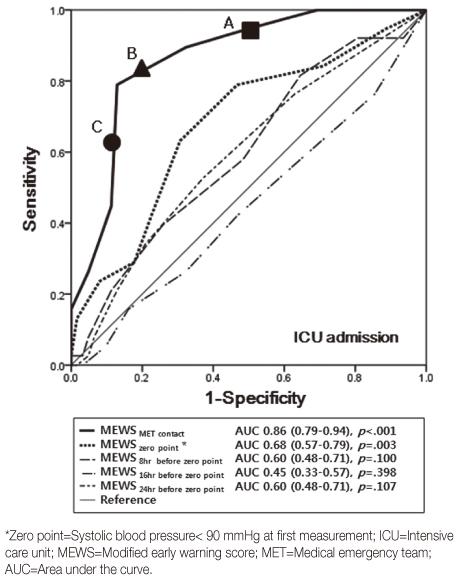
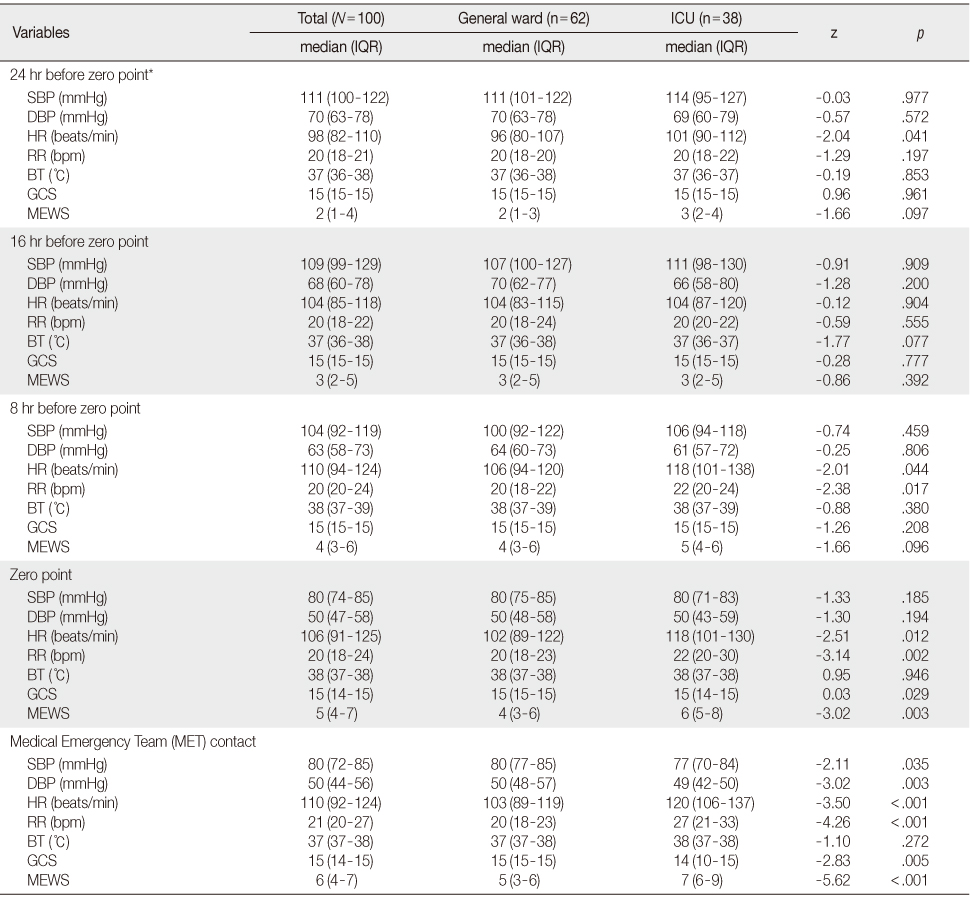
*Zero point=Systolic blood pressure<90 mmHg at first measurement; ICU=Intensive care unit; Median (IQR)=Median (Interquartile range); SBP=Systolic blood pressure; DBP=Diastolic blood pressure; HR=Heart rate; RR=Respiratory rate; bpm=breaths per minute; BT=Body temperature; GCS=Glasgow coma scale; MEWS=Modified early warning score.
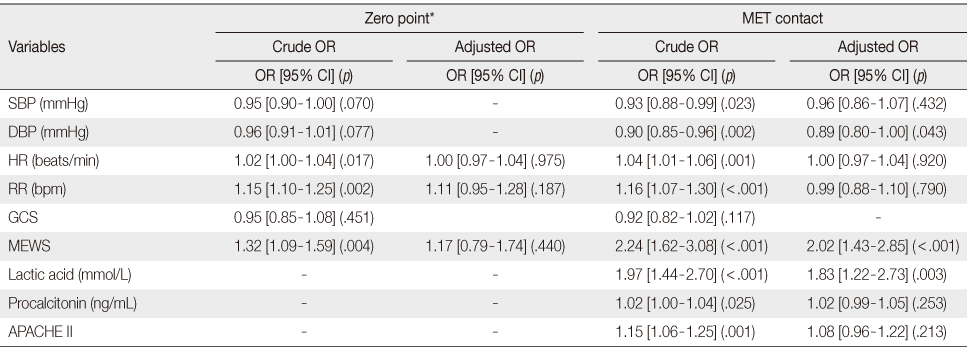
*Zero point=Systolic blood pressure<90 mmHg at first measurement; ICU=Intensive care unit; MET=Medical emergency team; OR=Odds ratio; CI=Confidence interval; SBP=Systolic blood pressure; DBP=Diastolic blood pressure; HR=Heart rate; RR=Respiratory rate; bpm=breaths per minute; GCS=Glasgow coma scale; MEWS=Modified early warning score; APACHE=Acute physiology and chronic health evaluation.
Figure & Data
REFERENCES
Citations

- Modified Early Warning Score (MEWS) as a predictor of intensive care unit admission in cancer patient on chemotherapy with positive blood culture: A retrospective cohort study
Jawad Allarakia, Taher Felemban, Amer Alghamdi, Abdullah Ashi, Yousef M. Al Talhi, Ashraf Alsahafi, Abdulfatah Alamri, Mona Aldabbagh
Journal of Infection and Public Health.2023; 16(6): 865. CrossRef - Korean nurses’ perception and performance on communication with physicians in clinical deterioration
Bo-Gyeong Jin, Kyoungrim Kang, Hyun-Jin Cho
Medicine.2022; 101(38): e30570. CrossRef - Job Analysis for Nurse-led Rapid Response Teams in Korea
Ju-Ry Lee, Eui Geum Oh, Eun-Young Yoo
Journal of Korean Academy of Nursing Administration.2021; 27(1): 43. CrossRef - Implementing the National Early Warning Score 2 into pre-registration nurse education
Zoe Abigail Butler
Nursing Standard.2020; 35(3): 70. CrossRef - Derivation and validation of modified early warning score plus SpO2/FiO2 score for predicting acute deterioration of patients with hematological malignancies
Ju-Ry Lee, Youn-Kyoung Jung, Hwa Jung Kim, Younsuck Koh, Chae-Man Lim, Sang-Bum Hong, Jin Won Huh
The Korean Journal of Internal Medicine.2020; 35(6): 1477. CrossRef - Performance of Three Scoring Systems in Predicting Massive Transfusion in Patients with Unstable Upper Gastrointestinal Hemorrhage
Dong Hun Lee, Kyeung Mi Lee, Sung Min Lee, Byung Kook Lee, Yong Soo Cho, Goeun Choi, Seong Woo Yun
Yonsei Medical Journal.2019; 60(4): 368. CrossRef - Implementation of the Surviving Sepsis Campaign guidelines
Vikramjit Mukherjee, Laura Evans
Current Opinion in Critical Care.2017; 23(5): 412. CrossRef - Strengths and limitations of early warning scores: A systematic review and narrative synthesis
C.L. Downey, W. Tahir, R. Randell, J.M. Brown, D.G. Jayne
International Journal of Nursing Studies.2017; 76: 106. CrossRef - Senior Nursing Students' Perceived Competence of Intensive and Critical Care Nursing
Jin-il Kim, Doo Ree Kim, Hyo Nam Lim
The Journal of Korean Academic Society of Nursing Education.2016; 22(2): 115. CrossRef - Temporal changes in physiological parameters of systemic inflammatory response syndrome during the three days prior to a diagnosis of sepsis: a case–control study
HyunSoo Oh, EunKyoung Bae, SeonYoung Lim, JiHye Oh, SunYoung Han, WhaSook Seo
Journal of Clinical Nursing.2016; 25(21-22): 3176. CrossRef - Analysis of Risk Factors to Predict Intensive Care Unit Transfer in Medical in-Patients
Ju Ry Lee, Hye Ran Choi
Journal of Korean Biological Nursing Science.2014; 16(4): 259. CrossRef

Figure 1
Modified Early Warning Score
AVPU=Alert, verbal, pain, unresponsive.
Baseline Characteristics of Sample
*Yates' correction; †Fisher's exact test; M (IQR)=Median (Interquartile range); ICU=Intensive care unit; APACHE=Acute physiology and chronic health evaluation.
Physiological Parameters and MEWS Dichotomized according to Point of Time
*Zero point=Systolic blood pressure<90 mmHg at first measurement; ICU=Intensive care unit; Median (IQR)=Median (Interquartile range); SBP=Systolic blood pressure; DBP=Diastolic blood pressure; HR=Heart rate; RR=Respiratory rate; bpm=breaths per minute; BT=Body temperature; GCS=Glasgow coma scale; MEWS=Modified early warning score.
Logistic Regression Analysis for ICU Transfer
*Zero point=Systolic blood pressure<90 mmHg at first measurement; ICU=Intensive care unit; MET=Medical emergency team; OR=Odds ratio; CI=Confidence interval; SBP=Systolic blood pressure; DBP=Diastolic blood pressure; HR=Heart rate; RR=Respiratory rate; bpm=breaths per minute; GCS=Glasgow coma scale; MEWS=Modified early warning score; APACHE=Acute physiology and chronic health evaluation.
AVPU=Alert, verbal, pain, unresponsive.
*Yates' correction; †Fisher's exact test; M (IQR)=Median (Interquartile range); ICU=Intensive care unit; APACHE=Acute physiology and chronic health evaluation.
*Zero point=Systolic blood pressure<90 mmHg at first measurement; ICU=Intensive care unit; Median (IQR)=Median (Interquartile range); SBP=Systolic blood pressure; DBP=Diastolic blood pressure; HR=Heart rate; RR=Respiratory rate; bpm=breaths per minute; BT=Body temperature; GCS=Glasgow coma scale; MEWS=Modified early warning score.
*Zero point=Systolic blood pressure<90 mmHg at first measurement; ICU=Intensive care unit; MET=Medical emergency team; OR=Odds ratio; CI=Confidence interval; SBP=Systolic blood pressure; DBP=Diastolic blood pressure; HR=Heart rate; RR=Respiratory rate; bpm=breaths per minute; GCS=Glasgow coma scale; MEWS=Modified early warning score; APACHE=Acute physiology and chronic health evaluation.
 KSNS
KSNS
 E-SUBMISSION
E-SUBMISSION
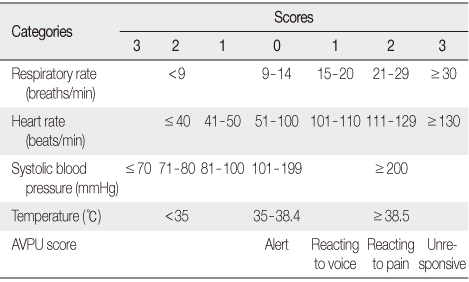
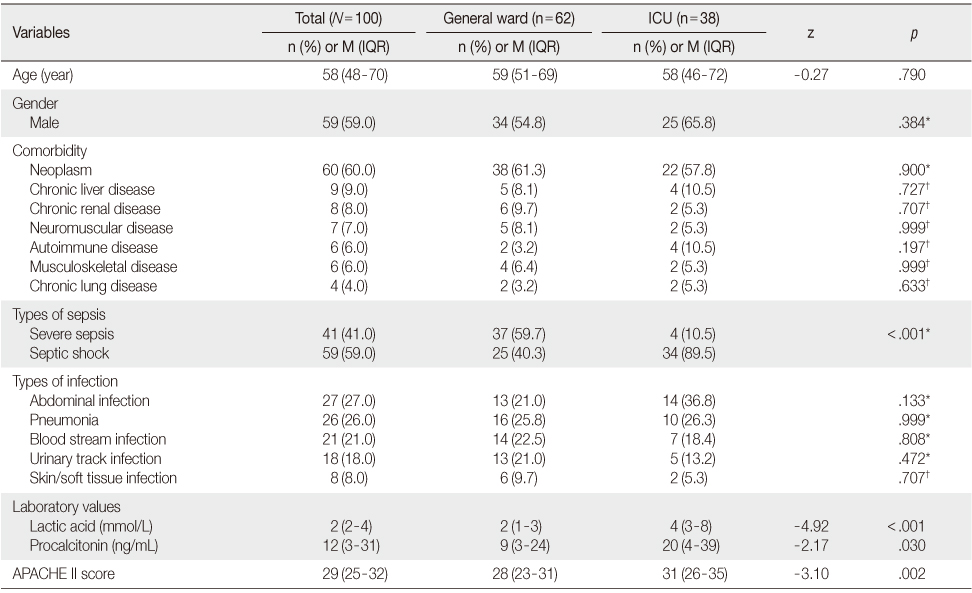
 Cite
Cite

